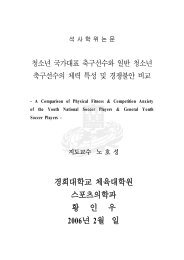경희대학교 동서의학대학원 의 학 영 양 학 과 김 선 아
경희대학교 동서의학대학원 의 학 영 양 학 과 김 선 아
경희대학교 동서의학대학원 의 학 영 양 학 과 김 선 아
Create successful ePaper yourself
Turn your PDF publications into a flip-book with our unique Google optimized e-Paper software.
three-dimensional architecture. The polypeptide chains of the two amino<br />
acids, alternating with one another and punctuated by the presence of<br />
certain other amino acids, are coiled in a left-handed helix. Three of these<br />
helical strands are twisted around on another, like strands of a rope, in a<br />
right handed super-helix, to compose the complete molecule.<br />
Understandably, the synthesis of this structure proceeds in steps. While it<br />
has been known for half a century that ascorbic acid is essential to the<br />
manufacture of collagen, the process is only now yielding to inquiry. It<br />
appears that ascorbic acid is involved at every step.<br />
First, a three dimensional stranded structure is assembled, with the amino<br />
acids glycine and proline as its principal components. This is not yet<br />
collagen but its precursor, procollagen. A recent study shows that ascorbic<br />
acid must have an important role in its synthesis. Prolonged exposure of<br />
cultures of human connective-tissue cells to ascorbate induced an eight-fold<br />
increase in the synthesis of collagen with no increase in the rate of<br />
synthesis of other proteins.(Mirad et al. 1981) Since the production of<br />
procollagen must precede the production of collagen, ascorbic acid must<br />
have a role in this step, the formation of the polypeptide chains of<br />
procollagen, along with its better understood role in the conversion of<br />
procollagen to collagen.<br />
The conversion involves a reaction that substitutes a hydroxyl group, OH,<br />
for a hydrogen atom, H, in the proline residues at certain points in the<br />
polypeptide chains, converting those residues to hydroxyproline. This<br />
hydroxylation reaction secures the chains in the triple helix of collagen. The<br />
hyhdroxylation, next, of the residues of the amino acid lysine, transforming<br />
them to hydroxylysine, is then needed to permit the cross-linking of the<br />
- 36 -

















